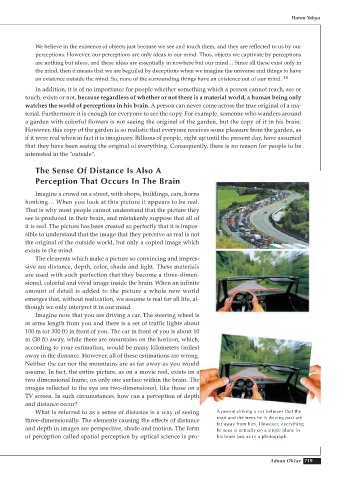Page 721 - Atlas of Creation Volume 3
P. 721
Harun Yahya
We believe in the existence of objects just because we see and touch them, and they are reflected to us by our
perceptions. However, our perceptions are only ideas in our mind. Thus, objects we captivate by perceptions
are nothing but ideas, and these ideas are essentially in nowhere but our mind… Since all these exist only in
the mind, then it means that we are beguiled by deceptions when we imagine the universe and things to have
an existence outside the mind. So, none of the surrounding things have an existence out of our mind. 14
In addition, it is of no importance for people whether something which a person cannot reach, see or
touch, exists or not, because regardless of whether or not there is a material world, a human being only
watches the world of perceptions in his brain. A person can never come across the true original of a ma-
terial. Furthermore it is enough for everyone to see the copy. For example, someone who wanders around
a garden with colorful flowers is not seeing the original of the garden, but the copy of it in his brain.
However, this copy of the garden is so realistic that everyone receives some pleasure from the garden, as
if it were real when in fact it is imaginary. Billions of people, right up until the present day, have assumed
that they have been seeing the original of everything. Consequently, there is no reason for people to be
interested in the "outside".
The Sense Of Distance Is Also A
Perception That Occurs In The Brain
Imagine a crowd on a street, with shops, buildings, cars, horns
honking… When you look at this picture it appears to be real.
That is why most people cannot understand that the picture they
see is produced in their brain, and mistakenly suppose that all of
it is real. The picture has been created so perfectly that it is impos-
sible to understand that the image that they perceive as real is not
the original of the outside world, but only a copied image which
exists in the mind.
The elements which make a picture so convincing and impres-
sive are distance, depth, color, shade and light. These materials
are used with such perfection that they become a three-dimen-
sional, colorful and vivid image inside the brain. When an infinite
amount of detail is added to the picture a whole new world
emerges that, without realization, we assume is real for all life, al-
though we only interpret it in our mind.
Imagine now that you are driving a car. The steering wheel is
at arms length from you and there is a set of traffic lights about
100 m (or 300 ft) in front of you. The car in front of you is about 10
m (30 ft) away, while there are mountains on the horizon, which,
according to your estimation, would be many kilometers (miles)
away in the distance. However, all of these estimations are wrong.
Neither the car nor the mountains are as far away as you would
assume. In fact, the entire picture, as on a movie reel, exists on a
two dimensional frame, on only one surface within the brain. The
images reflected to the eye are two-dimensional, like those on a
TV screen. In such circumstances, how can a perception of depth
and distance occur?
What is referred to as a sense of distance is a way of seeing A person driving a car believes that the
road and the trees he is driving past are
three-dimensionally. The elements causing the effects of distance
far away from him. However, everything
and depth in images are perspective, shade and motion. The form he sees is actually on a single plane in
of perception called spatial perception by optical science is pro- his brain just as in a photograph.
Adnan Oktar 719

